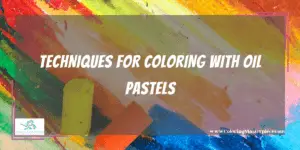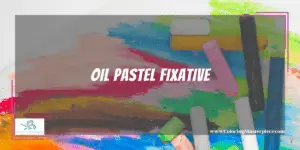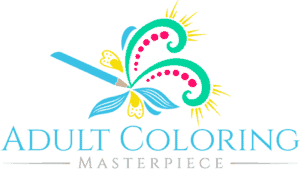Oil pastels are a fun tool that most people associate with canvas. They can be used in a lot of different ways because of their unique oil and wax binder. Some of the other surfaces you can use them on are glass, wood, and coloring books.
Techniques for coloring with oil pastels

When coloring with oil pastels in a coloring book you can color the traditional way, back and forth. You can also color in circles, in this way, oil pastels are like crayons and even colored pencils. Because oil pastels are such a thick medium you won’t have to worry as much about seeing the strokes, you still will a little bit, but not as much though. Also, coloring in circles gives the piece you are working on a more organic feel. Swirls also help you to color in a balanced way, it keeps you from applying more pressure on the pastel at certain points than others.
There is a way in which oil pastels are like other mediums, you can use layers to hide anything unwanted in your coloring page. Also, the way you layer oil pastels is similar to tools like colored pencils and especially markers. It is suggested that you start out using the lightest color you want to use. Make sure to lay down a decent-sized layer so you have a lot to work with. Then work your way up to the darker colors.
A great tip is to save the background for last, this can hide your mistakes. If you want to use the background this way consider using darker colors. Lighter tints won’t hide mistakes well. Start with lighter colors and work your way up to filling in the dark background.
High Quality vs. Cheap Oil Pastels
It is also important to note that oil pastels are a tool that has a noticeable difference in quality. So spending a little extra money on your pastels may be something to consider. This is usually because there is less filler (which includes things like chalk) in the high-quality pastels and you get a smoother coloring experience. But cheaper oil pastels with more filler are sturdier and crumble less, which is why they are good for students who are just starting.
Blending with your hands
To get started blending oil pastels you can use the most simple of tools. You can start right away by using your fingers to blend oil pastels. The pastels will melt under the heat of your hands to sort of fuse the colors into the page. If you don’t want to get your hands dirty from blending you can also use a blending stick. A blending stick is a pretty cheap tool you can find at most art stores in a multi-pack.
A blending stick
Using a blending stick will not only keep your hands but help you to be more precise in your blending. That is because the blending sticks have pointed ends. They also are easy to keep sharp, some you can simply sharpen with a pencil sharpener, and others you can peel away the end. These blending tools sometimes look a bit dirty, but just try sharpening them, and the tip will be as good as new.
Baby wipes
Also, when you blend/color you may want to keep a package of baby wipes on hand. Baby wipes work well to clean up any additional colors your oil pastels may accumulate from blending and just general coloring. Using the wipes is easy merely wipe away the undesired color from your tool. They are also handy for cleaning up small smudges on your hands.
Also, be careful not to blow the pastel dust off your paper, instead gently tap it into a trash can. Because when you blow the dust off your paper, you can accidentally breathe in the dust which can be a health hazard. Once you have discarded the dust and are finishing up your coloring page. If you are concerned about keeping what you created for the long term you may want to apply a fixative. You should keep in mind while coloring oil pastels are hard to keep in place, so you need a game plan.
You can always consider framing your coloring page under glass. This is the best way to prevent smudges, scratches, and other imperfections that time brings. However, not everyone is interested in framing their work. So there are other options to keep your pastels clean and bright.
Learn more about oil pastels HERE.
Oil Pastel Fixative

Some oil pastels never fully dry if this is the case and you are not looking to frame your work, consider using a spray fixative. If using a spray fixative, do not apply indoors. Because you do not want to breathe these in. To take extra precautions outdoors consider putting the page in a cardboard box before spraying it to keep the wind from blowing the fumes at you. Maybe even wear a mask and gloves for extra protection.
Other options
There are more ways to preserve your oil pastels. There is a gel you can apply to the top of your pastels. The brand Liquidex makes an artist-grade gloss gel you can use to keep your pastels in place. They also make a matte medium version too, if you don’t want your pastels to look shiny. These are an easier version of the spray fixative. You can spread these over the oil pastels with a paintbrush.
Final Remarks
When coloring with oil pastels you can expect vibrancy. They can make whatever you are coloring look pretty good. Also, they are fun to work with and even soft in your hands. However, they are super easy to smear, so you need to be careful with them. Once you have finished you will want to frame such bright colors. The vibrancy of oil pastels is worth the extra effort.
Yes, smearing is easy but you can color a vibrant sunset and flowers like nature intended them. All it takes is a little patience, a little practice, and some thoughtfulness which is what you want from adult coloring away. Adult coloring has been compared to meditation many times before, you may find the stress from your day melting away as you bend a pastel flower. This makes them similar to other coloring mediums (like colored pencils and markers), if you take the time to learn their potential you can discover something special.
Learn more with my free adult coloring eBook and by signing up for my email newsletter HERE!
Disclaimer: The information provided by ColoringMasterpiece.com (“The Site”) is for general informational purposes only. All information on the Site is provided in good faith, however, we make no representation or warranty of any kind, express or implied, regarding the accuracy, adequacy, validity, reliability, availability, or completeness of any information on the Site. Under no circumstance shall we have any liability to you for any loss or damage of any kind incurred as a result of the use of the Site or Reliance on any information provided on the Site. Your use of the Site and your reliance on any information on the Site is solely at your own risk. This blog post is for educational purposes only and does not constitute legal advice. Please consult a legal expert to address your specific needs.
Terms and Conditions: https://coloringmasterpiece.com/terms-and-conditions/
